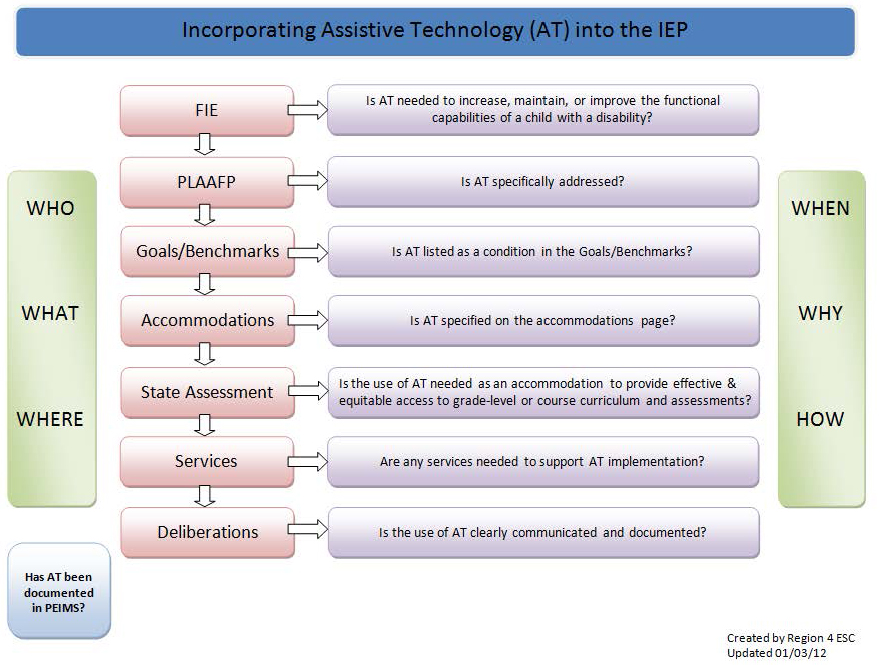How is the need for Assistive Technology determined?
For every student who receives special education services, the ARD committee must consider the student’s potentialneed for Assistive Technology (AT). This does not necessarily mean that all students require a formal AT evaluation. The potential need for AT should be explicitly discussed and documented in the IEP records and not simply a “check box” section on the IEP form.
Consideration should occur as a natural part of the IEP process. During the evaluation for eligibility, review of present levels (PLAAFP), and development of IEP goals and objectives, the ARD committee members will determine if they have adequate information to make a decision regarding technology needs or if more information is needed.
While considering the need for AT, the team should discuss the following questions:
- Is the student using AT as an accommodation or modification that has enabled him to reach the present levels of performance in any area?
- If the student currently uses AT, will the AT support the student while working on new goals and objectives?
- What specific tasks must the student be able to do to work toward mastery of the goals & objectives?
- Are there any tasks that are difficult or impossible for the student?
- Are core instructional materials used during those tasks accessible for the student?
- Is AT needed for the student to access the general curriculum?
- Is AT needed for the student to access instructional materials?
- Is AT needed for the student to access the technology used by the other students?
- Could AT help the student work more independently, more effectively or more efficiently?
- Is the AT device and/or service necessary in order for the student to receive FAPE?

There are many items and devices that, depending on the child’s needs, can be considered Assistive Technology. The ARD committee should consider the following areas of (potential) need when determining the need for Assistive Technology:
- Writing
- Spelling
- Reading
- Math
- Study/Organizational Skills
- Hearing/Seeing
- Communication
- Activities of Daily Living/Self care
- Recreation, Leisure, and Adapted Play
- Positioning, Seating, and Mobility
- Computer access
By discussing the above questions and areas of possible need, the ARD/IEP team will then determine which of the following three conclusions best represents the student’s need for AT:

1. AT is not required because it is anticipated the student will be able to access the curriculum and make reasonable progress on his educational program without AT devices and services. If the ARD committee decides that AT is not required, reasons for this decision and any supporting evidence (data) must be documented in the IEP.
2. AT is required for the student to access the curriculum and make reasonable progress in his educational program. If the ARD committee determines that AT is required based on the results of review of PLAAFP or an evaluation, they may decide:
- The same technology used will be needed to support working toward mastery of new goals;
- Additional or different technology is needed to work toward mastery of new goals; OR
- The student will be unable to participate adequately or make progress in IEP without AT devices and/or services.
If the ARD committee feels it knows the characteristics of the AT that would benefit the student but needs additional guidance in choosing the specific piece of AT, additional consultation will be sought from others who have more experience with AT. Several pieces of AT may be tried to determine the most beneficial AT for the student.
If the ARD committee determines that AT devices and/or services would benefit a child with a disability, then those devices/services must be included in an IEP as one or more of the following components:
- part of a child’s special education services
- a related service
- supplementary aid or service to ensure that the child is educated in the least restrictive environment
If AT is a component of the IEP, it must be provided to the student.
3. More information is needed before a decision can be made. In this case, a referral for an evaluation would be made and consent would be needed from the parent. If the ARD committee feels more information is necessary, the team may request an AT evaluation that will take place in the student’s natural environment and across all settings. The evaluation process may be fairly simple, or it may involve several professionals and types of AT. If an evaluation is requested by the ARD committee, then the school district must perform a timely evaluation in order to assess the specific educational needs of the student.
When an AT evaluation is requested for a student, the ARD Committee may ask other individuals who know the student’s strengths and weaknesses to serve on the multi-disciplinary team. This complete team considers the demands of the student’s environment, the student’s educational objectives, and different forms of AT.
The ARD Committee’s decision on the student’s use of Assistive Technology devices and/or services, and any consultation and training that is necessary must be recorded in the ARD paperwork.
What Parents Need to Know
- There is no “eligibility” criteria for AT.
- Consideration of AT is not merely a checkbox on the IEP – it is a process that requires thought, conversation, review of data and possible observation, as well as parent input.
- Consideration of AT should be an ongoing process that can be revisited at any time there is concern related to the student’s ability to access the general curriculum.
- When documenting the need for AT in the student’s IEP, additional information should also be documented, such as the type of AT to be used, any training that is needed, the time frame for which data on the use of AT will be reviewed for progress, and the time frame for which the AT will be used.
- A school district is not required to provide a student with the best or highest technology available, but technology that provides some meaningful educational benefit.
- A district cannot cite “lack of finances or personnel” as reasons for not providing AT.
- Keep in mind that students who are not identified for special education services under the IDEA, but do qualify under Section 504, may require AT services as related aids and services in order for them to receive FAPE. AT falls within the definition of “auxiliary aids and services” under Title II of the ADA, and some students with disabilities who do not qualify for IDEA services may have a right to AT services under Title II.
Next Steps




